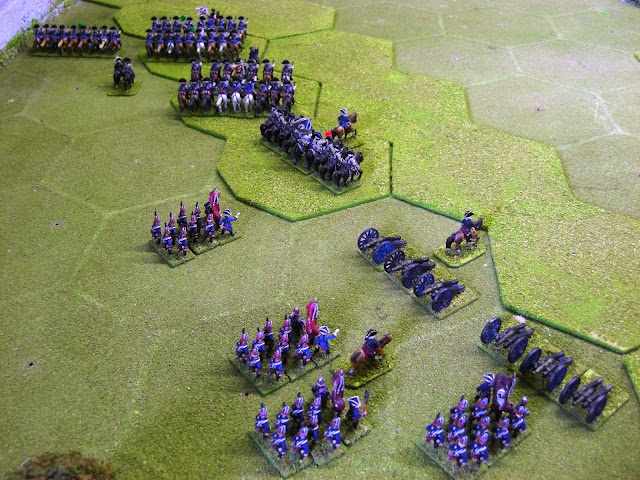Six of us traveled up to Micks in order to take part in the Seven Years war battle of Paltzig 1759. Rules used were Mick and Mikes, Gaming room Mick's.
Unashamedly copied from Wikipedia:
At the end of April 1759, a large Russian army (about 70,000 men) started its advance on Brandenburg. Dohna, the commander of the small Prussian army (18,000) in this area, was very slow to react.
At the beginning of June, the Russian army, now under general Piotr Semionovitch Saltykov, had managed to concentrate at Posen (actual Poznań) without any interference from Dohna. Saltykov then proceeded to the invasion of Brandenburg, starting his advance on Crossen (actual Krosno).
By July 17, the Russians had reached the area of Züllichau (actual Sulechów) a few km from the Oder river. Dohna failed to interpose his small army between the Russians and the bridge at Crossen. Frederick II quite upset by Dohna's inefficiency despatched lieutenant-general Kurt Heinrich von Wedel to replace Dohna.
Wedel reached his army in the evening of Saturday July 22.
Initial Manoeuvres
On July 23 at daybreak, Wedel set out to reconnoitre the ground and to see with his own eyes the army that he was supposed to stop. The heavily wooded area prevented him from seeing very much, but he saw glimpses of stationary troops that he mistook for the Russian left wing while they were in fact the rearguard. This led him to think that the whole Russian army was still idle and that therefore he still had time to outmanoeuvre it. Indeed, the Russians were already on the move to march towards Crossen by Heinersdorf (unidentified location), Nickern (actual Niekarzyn) and Paltzig (actual Palck) to eventually make a junction with an Austrian corps led by Hadik and Loudon.At 10:00 AM, Wedel returned to the Prussian camp at Züllichau reassured about the intention of the Russians.
However, at 11:00 AM, the heads of the Russian columns began to emerge from the woods in full view of the astonished Prussian left wing in front of the village of Paltzig about 9 km from Züllichau. Wedel was immediately informed but did not believe the report and went personally to observe the Russian troops.
Wedel could not ignore that the king had dismissed Dohna for being too cautious, he was under pressure and he took a step that under different circumstances he probably would never have taken, he decided to attack the Russian army while it was on the march. Some Prussian generals were not sharing his confidence. General Wobersnow pointed out that the enemy was probably 40-50,000 strong with plenty of artillery pieces while their own army could not muster more than 27,000 and “I know not if we can bring a single cannon to where Saltykov is.” (Tempelhof iii 132-134).
Nevertheless, Wedel ordered his troops to march in 2 columns by the left: the first towards Kay (actual Kije) and the second towards Mohsau (actual Mozow).
The ground separating the two armies was hiding quite a number of unpleasant surprises, first there was a little stream running from Kay to the Oder. The banks of this stream were marshy and it could not be forded. Men could only pass it by using a narrow road leading to a small bridge in the proximity of the mill of Kay. There was also a second brook, a branch of the first one and this time there was no bridge across it.
If you wish to read an account of the actual battle then look Here
Pictures say a thousand words so here we go.
A view of the initial deployments, the Russian centre and left (to the top of the picture) with the village of Paltzig top left and Glogsen centre right. The Prussians have deployed artillery in front of Glogsen and their massed infantry is about to set up behind the Hussars visible bottom right the area to the top of the picture was ignored by the Prussian commanders who concentrated all their forces to their left:
The Prussian infantry attack went in and smashed the first Russian line and a second became visible behind the ridge:
With a third forming up and a fourth re-deploying from their left wing:
Back on the Prussian left the cavalry division pressed forward taking on and defeating fresh Russian reserve cavalry arriving to save the day, this end of the ridge (center right of the picture) has been taken by the Prussian infantry:
Though successful on the left and having taken the ridge to their front the Prussian attack had simply run out of steam. The Russians had lost a huge number of troops but of course could afford to do so.
The road to Berlin was still blocked so the Russian commanders had achieved their objectives but it must be said that the Prussians could not have done more with the troops available. A closer run thing than on the day of the actual battle.
As usual the game was great as was the company, thanks to you all gents.
Dave

















About time mate. It was a great game. With a few more troops I reckon we would have broken through.
ReplyDeleteAbout time, if I'd left it any longer Neal (with his memory) would have convinced himself we HAD broken through!
ReplyDeleteDave
Wow! Great looking game. Who makes the hex mat by the way?
ReplyDeleteNo hex mat Steve, this table is a permanent setup in Mick's garage, lucky bugger! The terrain is all based on hexes as are his home made rules and he builds marks out and flocks it all himself.
ReplyDeleteI'm soooo jealous.
Dave
Wow! Looks fantastic!
DeleteThis looks very cool, nice game.
ReplyDeleteDidn't we break through then?
ReplyDelete